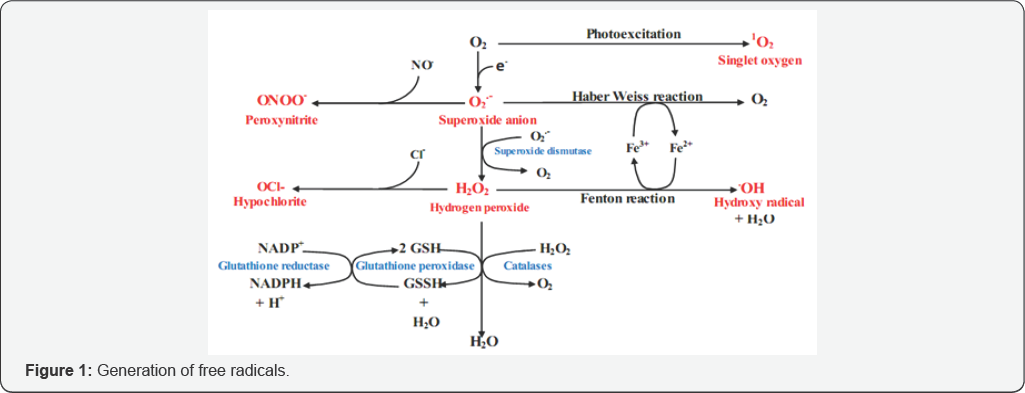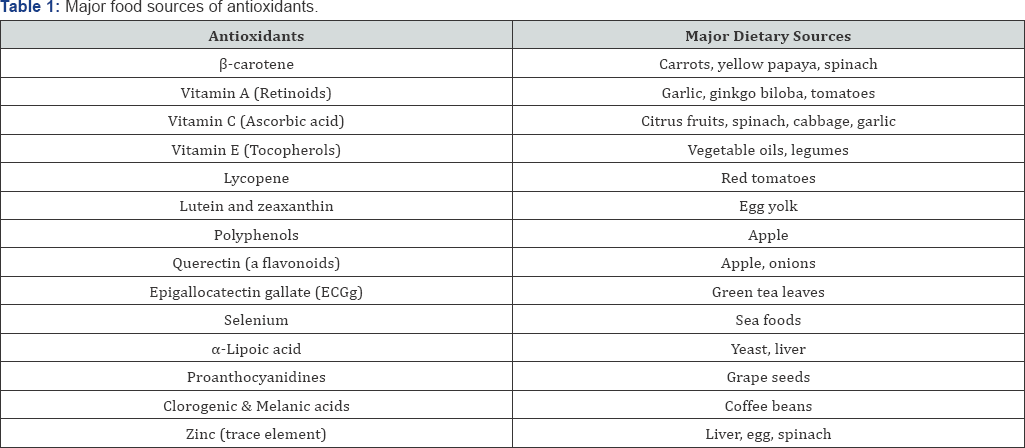The Anti-aging Efficacy of Antioxidants
Livinus Miracle Uwa*
Department of Biochemistry and Molecular Biology, Nasarawa State University-Keffi, Nigeria
Submission: February 19, 2017; Published: August 24, 2017
*Corresponding author: Livinus Miracle Uwa, Department of Biochemistry and Molecular Biology, Nasarawa State University-Keffi, Nigeria, Email: livinusmiracle2009@yahoo.com
How to cite this article: Livinus M U. The Anti-aging Efficacy of Antioxidants. Curr Trends Biomedical Eng & Biosci. 2017; 7(4): 555716. DOI: 10.19080/CTBEB.2017.07.555716.
Abstract
Aging is a nature's deliberate ordered-structure of existence for all living system. It is an irreversible phenomenon whereby cell division and replacement of dead or damaged cells slows down. Cell death, mutation or damage is partly caused by the free radicals that the body constantly produces, hence the conception of the free radical theory of aging. Increased cellular and DNA damage or mutation, as we age, eventually results in various age-related diseases such as cancer, cardiovascular heart disease, brain damage and Alzheimer's disease. Most of the diseases -as result of cell and molecular damage-manifested with aging are caused by free radicals and nutrient deficiency. Genetics is one factor that determines aging process and our health condition. Nevertheless, nutrition, lifestyle, and other factors also determine how healthy the aging process can be. Making our diet rich in fresh vegetables, fruits, and whole grain foods and daily adequate physical exercise provide the essential nutrients, vitamins, protein, dietary fiber and antioxidants our body needs and are natural and potent anti-aging therapy and thus for healthy function.
Keywords: Aging; Antioxidant; Nutrition; Free radicals; Disease; Senescence
Introduction
Aging is described as a biological process, which causes increased susceptibility of organism to disease. It is also the gradual decline in the physiological functions and adaptation of the organism to its normal environment, following the onset of reproductive maturity.
The state or process of aging in called Senescence. Cellular senescence is a phenomenon where isolated cells demonstrate a limited ability to divide in culture [1], while organismal senescence is the aging of organisms. After a period of near perfect renewal (in humans, between 20 and 35 years of age), organismal senescence is characterized by the declining ability to respond to stress, increasing homeostatic imbalance and increased risk of disease. This currently irreversible series of changes inevitably ends in death. In humans and other animals, cellular senescence has been attributed to the shortening of telomeres with each cell cycle; when telomeres become too short, the cells die. The length of telomeres is therefore the "molecular clock," [2].

Free radicals (Reactive Oxygen Species-ROS)
Free radicals are atoms or groups of atoms with an odd (unpaired) number of electrons and can be formed when oxygen interacts with certain molecules (Figure 1) [3,4]. Once formed these highly reactive radicals can start a chain reaction. Their chief danger comes from the damage they can do when they react with important cellular components such as DNA, or the cell membrane. Cells may function poorly or die if this occurs.
Under normal conditions about 1% of reactive oxygen species (ROS) daily escapes the control of the endogenous anti-oxidant defenses and contributes to oxidative damage of surrounding tissues, consequently promoting and developing the aging process. ROS can attack any biochemical component of the cell. If the body or cell capacity to neutralize ROS is altered, then they will produce acute damage to vital proteins, lipids and DNA. In humans, unbalance between ROS production and endogenous antioxidants has been involved in the generation or worsening of more than a hundred pathologic conditions [4].
Free radicals and skin aging
There are two types of aging in the skin: intrinsic or chronologic aging, and extrinsic or environmental aging. In intrinsic aging, free radicals are formed naturally through normal metabolism. Here, cellular mechanisms become less efficient resulting in fine wrinkles and a relaxed appearance. In extrinsic aging, the skin suffers additional free radical damage from exogenous factors such as UV exposure, cigarette smoking and air pollution. These environmental stressors not only accelerate skin aging, but are distinctly responsible for skin damage leading to deep wrinkles, hyper-pigmentation, chronic inflammation, abnormal elastin formation, and cancer, not present in chronological aging alone.
Antioxidants
These are molecules that can neutralize free radicals by accepting or donating an electron to eliminate the unpaired condition. They are natural scavengers of free radicals, known to cause cellular damage and consequent age-related medical disorders (including wrinkling of skin). Antioxidants’ antiaging benefit is due to their anti-inflammatory effect, delay or prevention of cancer, diabetes, and brain disorders. Antioxidants also have the potential to lower blood pressure and reduce development of atherosclerosis. Antioxidant rich foods are also suggested for diabetic patients to help relieve the oxidative stress caused by increased free-radicals synthesis.
Dietary supplementary antioxidants
Dietary supplementary antioxidants are substances in foods that significantly decrease the adverse effects of reactive species, such as reactive oxygen and nitrogen species, on normal physiological function in humans.

Antioxidants have greater anti-inflammatory and anti- carcinogenic effect and the resultant anti-aging effect, when they are consumed in their natural food source than individual antioxidant elements. Foodstuffs contain a plethora of antioxidant and other phytochemicals that are not present in a single supplement pill. Besides, a combination of variety of antioxidants has a synergetic effect and can be obtained naturally from fruits, vegetables, herbs, teas, legumes and whole grain cereals. Table 1 reveals some main food sources of antioxidants that are needed in the body to scavenge the effects of free radicals.
Antioxidants and skin aging
Antioxidants neutralize these damaging free radicals by quenching the reactive molecules, thereby protecting cells from endogenous and exogenous stressors and prolonging their life and vitality. Under ideal circumstances, the skin uses a series of endogenous enzymatic and non-enzymatic oxidants to protect itself from free-radical damage. Enzymatic antioxidants include glutathione peroxidase, superoxide dismutase and catalase; non-enzymatic antioxidants include vitamin C, glutathione, vitamin E, coenzyme Q10 (ubiquinone-10), and alpha lipoic acid. It is known that exposure to UV light depletes these naturally occurring antioxidants as does chronologic aging. Without adequate antioxidant protection, free radicals generated are left unchecked, resulting in skin aging.
Noteworthy, supplementing the skin with additional antioxidants has been demonstrated to give additional protection from sun-induced damage, slow down skin aging, reduce inflammation and ultimately improve skin appearance. Cosmetic treatments of the latest generation, developed against wrinkles, rely on antioxidant properties of ingredients such as superoxide dismutase (SOD), Vitamins C, E and alpha lipoic acid, all and various plant extracts, such as acai berry, white and green tea, rosemary, and turmeric. Through topical (and also ingestible) application botanical antioxidants have attracted considerable attention for their ability to reduce the incidence of free radical mediated photo-carcinogenesis and photo-aging. Topical antioxidants are now recognized as an integral part of a comprehensive sun protection program and as a valuable addition to any anti-aging skin care regimen. As such, topical antioxidants have far-reaching benefits for protecting and improving UV-damaged and aging skin.
Conclusion
Aging in human and other mammals is associated with changes in body condition, body composition, energy requirements, declining organ function and immune status, and other metabolic changes. Nutrition may play an important role in delaying such changes or preventing their progression. In the older human population, a link between nutritional status, quality of life, and overall physical and cognitive health has been demonstrated. Nutritional and healthy lifestyle modifications initiated in older human individuals were positively related to reduce mortality risk and delayed deterioration in health status, indicating that even health promotion at older ages can contribute to healthy aging.
References
- Hayflick L, Moorhead PS (1961) The Serial cultivation of human diploid cell strains. Experimental Cell Res 25: 585-621.
- Hayflick L (1998) How and why we age. Exp Gerontol 33(7-8): 639653.
- Temple M (2005) Complex cellular responses to reactive oxygen species. Trends in Cell Biology 15(6): 319-326.
- Valko M, Rhodes CJ, Moncol J, Izakovic M, Mazur M (2006) Free radicals, metals and antioxidants in oxidative stress-induced cancer. Chem Biol Interact 160(1): 1-40.
- Halliwell B, Gutteridge JMC (1999) Free Radicals in Biology and Medicine (3rd edn), Oxford University Press, USA.






























